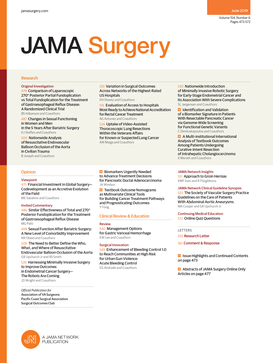Leveraging Lean Methodology to Improve Compliance With Work-Hour Restrictions
IF 15.7
1区 医学
Q1 SURGERY
引用次数: 0
Abstract
ImportanceSince work-hour restrictions were instituted in 2003, sustainably complying with duty-hour regulations remains a challenge for general surgery residency programs across the nation.ObjectiveTo determine whether industry-based process improvement techniques could be leveraged to increase compliance with work-hour restrictions within a general surgery residency.Design, Setting, and ParticipantsThis quality improvement project using Lean methodology was conducted from October to November of the 2021 to 2022 academic year. The setting was a university-based general surgery residency program in southern California with rotations across 5 regional hospitals. The program trains 7 categorical general surgery residents per postgraduate year (PGY) and offers an optional 1 to 3 years for research and career development.InterventionsProgrammatic structures were examined, current and target states were analyzed, opportunities for improvement were identified, root-cause analyses were conducted, and targeted interventions were developed.Main Outcomes and MeasuresResident time logs and annual Accreditation Council for Graduate Medical Education resident and faculty surveys were reviewed from academic years 2019/2020 to 2022/2023. Attending faculty were surveyed on resident preparedness using a 5-point Likert scale. Differences between means and proportions were calculated with corresponding 95% CIs.ResultsThe web-based survey responses of 29 residents (residents per PGY, 7 [PGY1], 14 [PGY2/3], 8 [PGY4/5]; 17 female [54.7%]) were included in this study. Root causes included maxed baseline schedules, late in shift work, culture, service variability, clinical volume, and inefficient workflows. Fifteen multifactorial interventions impacting call and weekend scheduling, work practices and efficiencies, intern and service orientations, and faculty and cultural expectations were implemented. The mean number of residents per block who logged more than 80 hours per week decreased by 3.6 violations per block (95% CI, 2.98-4.22), from 4.4 (12.4%) to 0.8 (2.2%) for a difference of 10.2% (95% CI, 8.4%-16.2%). On the annual resident survey, perceived compliance with 80 hours was 72%, 83%, 83%, and 88%, respectively, over the following study periods: 2019 to 2020, 2020 to 2021, 2021 to 2022, and 2022 to 2023. Faculty perception of resident preparedness for the case increased from a mean (SD) of 2.6 (0.8) to 3.0 (0.5), with a difference of 0.47 (95% CI, −0.52 to 0.68). There were no statistically significant differences in technical skill, clinical judgment, sense of responsibility, efficiency, or sense of well-being.Conclusions and RelevanceResults of this quality improvement study suggest that through Lean methodology, surgical residency programs can improve working environments. This novel approach can increase compliance with resident work hours by engaging front line trainees in the process.利用精益方法改善工时限制的合规性
自从2003年制定了工作时间限制以来,持续遵守值班时间规定仍然是全国普外科住院医师项目面临的一个挑战。目的确定是否可以利用基于行业的流程改进技术来提高普外科住院医师对工作时间限制的依从性。设计、设置和参与者使用精益方法的质量改进项目于2021至2022学年的10月至11月进行。背景是南加州的一个以大学为基础的普通外科住院医师项目,在5个地区医院轮流进行。该项目每个研究生学年(PGY)培训7名分类普外科住院医师,并提供1至3年的可选研究和职业发展时间。干预措施检查了规划结构,分析了当前和目标状态,确定了改进的机会,进行了根本原因分析,并制定了有针对性的干预措施。主要成果和措施从2019/2020学年到2022/2023学年,审查了住院医生的时间日志和研究生医学教育认证委员会的年度住院医生和教师调查。使用5分制李克特量表对住院医生的准备情况进行了调查。用相应的95% ci计算平均值和比例之间的差异。结果29名居民(每PGY1、7名[PGY1 /3]、14名[PGY2/3]、8名[PGY4/5])的网络调查反馈;17例女性(54.7%)纳入本研究。根本原因包括基线时间表的最大化、轮班工作的延迟、文化、服务的可变性、临床量和低效的工作流程。实施了15项多因素干预措施,影响电话和周末安排、工作实践和效率、实习生和服务导向以及教师和文化期望。每个街区每周工作时间超过80小时的居民平均数量减少了3.6次(95% CI, 2.98-4.22),从4.4次(12.4%)减少到0.8次(2.2%),差异为10.2% (95% CI, 8.4%-16.2%)。在年度居民调查中,在以下研究期间:2019年至2020年、2020年至2021年、2021年至2022年和2022年至2023年,人们认为遵守80小时的比例分别为72%、83%、83%和88%。教师对住院医师对病例的准备程度的感知从平均(SD) 2.6(0.8)增加到3.0(0.5),差异为0.47 (95% CI, - 0.52至0.68)。在技术技能、临床判断、责任感、效率或幸福感方面没有统计学上的显著差异。结论与相关性本质量改进研究的结果表明,通过精益方法,外科住院医师项目可以改善工作环境。这种新颖的方法可以通过让一线实习生参与到这个过程中来增加对住院医生工作时间的依从性。
本文章由计算机程序翻译,如有差异,请以英文原文为准。
求助全文
约1分钟内获得全文
求助全文
来源期刊

JAMA surgery
SURGERY-
CiteScore
20.80
自引率
3.60%
发文量
400
期刊介绍:
JAMA Surgery, an international peer-reviewed journal established in 1920, is the official publication of the Association of VA Surgeons, the Pacific Coast Surgical Association, and the Surgical Outcomes Club.It is a proud member of the JAMA Network, a consortium of peer-reviewed general medical and specialty publications.
 求助内容:
求助内容: 应助结果提醒方式:
应助结果提醒方式:


